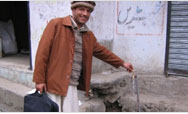You are here » Home » Telling Our Story
Case Study
Building a regional model for HIV/AIDS prevention and treatment
Building on Success to Fight HIV/AIDS

| |
Photo: FHI/Doaa Oraby
|
|
Dr. Riyad Abdulaziz al Khalif, Director of Saudi Arabia’s government-run HIV program, explains the regional impact of Egypt’s program at a USAID-sponsored workshop in Cairo, Egypt.
“I can return home and implement the action plan drafted during the workshop. With this we can make a difference,” said a participant at an HIV/AIDS USAID-sponsored workshop held in collaboration with the President’s Emergency Plan for AIDS Relief.
|
Challenge
Egypt’s low HIV/AIDS infection rate has kept the epidemic at bay, but without a dedicated effort to understand the problem’s scope and develop a model for dealing with it effectively, there is no guarantee the rate will stay low. Obstacles to gaining knowledge about HIV/AIDS in Egypt are plentiful — HIV/AIDS is considered a low health priority, little information exists on HIV cases and risk behavior, and cultural and social stigmas make it difficult for those at risk to access HIV testing and services.
Initiative
USAID launched Egypt’s first HIV/AIDS program in 1999. It focused on three priority areas: outreach to high-risk groups, voluntary counseling and testing, and providing care for those living with HIV/AIDS. The program conducted a study of high-risk populations, behavioral trends, and effective outreach strategies. Having ascertained that local organizations were the best way to reach high-risk populations and provide HIV/AIDS services, USAID developed partnerships with these organizations and established a network of voluntary counseling and testing centers, where anonymity was ensured to those seeking HIV/AIDS testing. The program also established a monitoring and evaluation system to identify successes and determine how to replicate them.
Results
The most evident sign of the program’s success is that it is being replicated on both a national and regional level. Since 1999, this ground-breaking program has evolved within Egypt and generated many requests for technical assistance for other countries in the Middle East. To help others replicate the program, USAID documented program successes, conducted regional workshops, and helped develop action plans with other countries. After the third workshop during the summer of 2006, technical experts will visit the countries where the program is being developed for follow-up consultations and to monitor progress. By helping create an effective, adaptable, and successful model, USAID is actively preventing the spread of HIV/AIDS in Egypt and the Middle East.
Print-friendly version of this page (424kb - PDF)
Click here for high-res photo
Back to Top ^ | 

